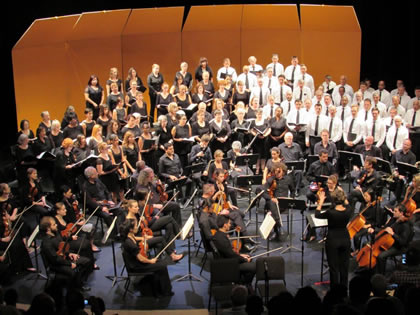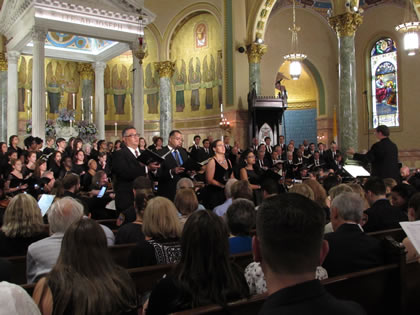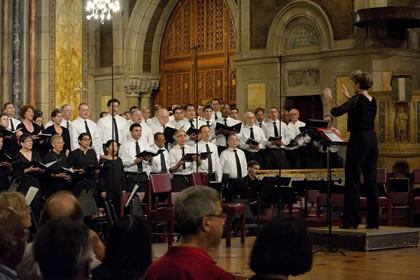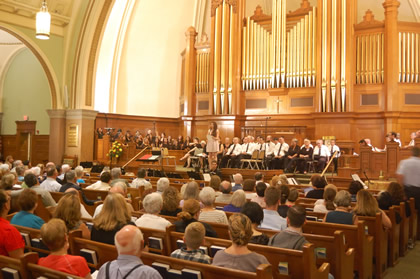9/11 2016: Manhattan, Mozart and the Power of Music
by Dennis Speed
September 2016
|
Diane Sare conducts the peformance of African-American spirituals in the auditorium at Lehman College in the Bronx, September 9, 2016. |
New York City’s Bronx, Manhattan and Brooklyn held commemorations of the 15th anniversary of the destruction of the World Trade Center towers, featuring full-orchestra/choral performances of Mozart’s great Requiem in D Minor this past weekend. The New York Schiller Institute Community Chorus, founded by musician and former Congressional candidate Diane Sare in the aftermath of the killing of Staten Island’s Eric Garner and two Brooklyn police officers, and as a crucial component of the Manhattan Project initiated by Lyndon LaRouche in the fall of 2014, provided 150 singers for this purpose. These singers, almost all non-professionals, were part of a living memorial not only to the victims of the horrific events of that day, but also to the living dead still terrorized by the fact that the perpetrators of that 9/11 mass-murderous crime have never been brought to justice.
|
New York firefighters carry their flags, one for each firefighter who died as a result of the rescue effort after the 9-11 attack, into St Joseph's Co-Cathedral in Brooklyn on September 11, 2016, "to symbolize the return home of their fallen comrades". |
The Mozart Requiem presented at St. Joseph’s Co-Cathedral in Brooklyn was a particularly unique moment in American history, and not merely in music. This was for several reasons. The Requiem was performed as part of a full Catholic Mass, probably the first of its kind in the United States since January 1964, when a similar ceremony was conducted in honor of the slain John F. Kennedy at the request of his wife, Jacqueline, at Boston’s Cathedral of the Holy Cross. The difference with even that occasion, though, was that this September 11, though the Requiem was to be performed, the Mass was not itself a requiem Mass, because such a Mass cannot be performed on a Sunday, the day of Christ’s resurrection in the Christian faith. Sunday cannot be a liturgical day of death, but must needs be a day of affirmation of life. The “Gloria” from the Mozart Mass in D Minor, K. 65, was therefore added. The Mass also concluded with “Worthy Is The Lamb That Was Slain/Amen," the end of Handel’s Messiah, employed as the dismissal hymn.
This annual Brooklyn ceremony is dedicated to and attended by the firefighters of Battalion 57 of the Fire Department of New York, 23 of whose members had given their lives for their country on September 11, 2001. Hundreds of firefighters attended. The Tablet, the diocese newspaper, reported that, “Prior to the Mass, members of the Battalion, which includes five engine companies and one ladder company in Brooklyn, marched from Ground Zero in Manhattan, over the Brooklyn Bridge, to St. Joseph’s Co-Cathedral, making stops at several firehouses along the way. They carried FDNY flags, one for each of their fallen members. ‘For the firefighters, the journey to Brooklyn served to symbolize the return home of their fallen comrades,’ said Firefighter Thomas Callahan, who delivered opening remarks at the church.”
|
John Sigerson conducts the peformance of Mozart's Requiem at the Co-Cathedral of St. Joseph, Brooklyn, September 11, 2016. |
|
Diane Sare conducts the peformance of four African-American spirituals in St. Bartholomew's Episcopal Church on Park Avenue at 51st Street in Manhattan, September 10, 2016. |
Bishop Nicholas DiMarzio and Msgr. Kieran Harrington concelebrated the Mass, attended by 1100-1200 people. Bishop DiMarzio’s homily was remarkable for its direct emphasis on the idea of forgiveness. He pointed out that the firefighter fulfills not only the New Testament admonition, “Greater love than this, no man hath, that a man lay down his life for his friends.” The firefighter does this for strangers, and even sometimes, his enemies, and he does that every day, as a vocation. The inclusion of the Requiem as part of the celebration of the Sunday Mass for September 11 was suggested by Msgr. Harrington.
The Brooklyn Reporter online newspaper said:
The Foundation for the Revival of Classical Culture presented a special performance of Mozart’s Requiem, a piece rarely performed during a Mass, according to the Diocese.
The Schiller Institute NYC Community Chorus, accompanied by a 42-piece orchestra and guest soloists, performed the Requiem at the “Verdi tuning” – a pitch that is mathematically consistent with sounds of the universe, making it an overall healing experience for listeners.
“Proper Verdi tuning allows for the most transparent blend of the human voice with the instruments, and thus, maximum sonority,” said Lynn Yen, the executive director of the Foundation for the Revival of Classical Culture. “To hear the Mozart Requiem at this pitch is to experience the transcendent power of sacred music—to experience the true glory of God and music.”
|
Lynn Yen introduces the presentation at the Presbyterian Church in Morristown, New Jersey, September 12, 2016. |
The Foundation for the Revival of Classical Culture sponsored the three New York City presentations of the piece, and one in Morristown, New Jersey.
The ensemble was directed by John Sigerson. Besides his skills as a vocalist and instrumentalist, Sigerson is the co-author of A Manual on Tuning and Registration, a 1992 book published by the Schiller Institute that argued persuasively for the Verdi tuning, also known as the scientific pitch. This pitch, a middle C equal to 256 cycles per second, is, contrary to the well-intended assertion in the Brooklyn Reporter, not mathematically, but physically consistent with the harmonic composition of the universe. This is a far more important, and controversial distinction than it might initially appear.
A MANUAL ON THE RUDIMENTS OF TUNING AND REGISTRATION |
|
| The tuning at which Classical music is played is neither a matter of popularity nor of taste, but goes to the essence of Classical composition. The Manual provides 300 musical examples that illustrate why Classical music is based on the C = 256 Hz tuning. The fundamental idea is that instrumental music is based upon the human singing voice, with its physiologically defined registers. The register changes occur to the best effect only at an orchestral tuning of C = 256 (A = 432) Hz. | |
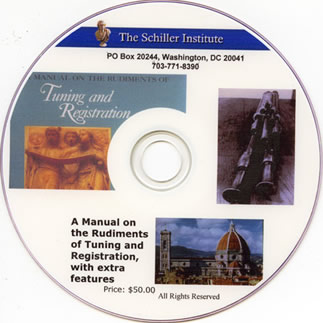 View full size |
|
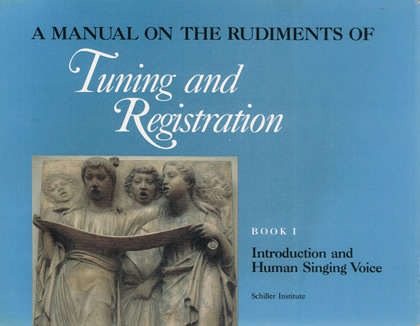 DVD with full PDF book and 4 Videos $50 |
|
| Order the DVD from the EIR Store Or address your orders to: The Schiller Institute • PO Box 20244 • Washington, DC 20041-0244 Tel: 703-297-8368 • E-Mail: schiller@schillerinstitute.org |
|
The following passage appears in the Foreword of the 1992 Music Manual:
“Take Kepler’s World Harmony as a point of reference. First, for the information of the person who has Alexander Pope’s ‘a little learning’ concerning physical-science matters, we emphasize that Isaac Newton did not ‘discover universal gravitation’.... In Newton’s schema, for example, the orbits of the planets and their moons can be situated at any distance from the Sun one might choose for situating a planet. One merely has to choose a mass and orbital velocity whose associated centrifugal force neatly balances the centripetal force, the gravitational ‘pull.’ In Kepler’s universe, this is not permitted. The number of possible orbits and orbital velocities is precisely determined. No orbits between any two of these determined paths is permitted. Kepler’s method permits the existence of no planetary orbits between those of Mercury and Venus, Venus and Earth, Earth and Mars, Mars and Jupiter, and so forth. Kepler requires one orbit between Mars and Jupiter, which Kepler assigns to ‘an exploded planet,’ i.e. the asteroid belt.”
The difference between Newton’s discredited, wrong, but still pervasive view of the universe, and that of Kepler, is that one is human, and the other not. As musician and physicist Albert Einstein once admonished his colleagues: “God does not play dice” with the universe. It was not an arbitrary decision to perform Mozart’s Requiem at the C=256 tuning. It is the only proper tuning for that piece, and for Classical music as a whole. Modalities change, and worldwide musical practice and forms are perhaps even unlimited, but there is, and can only be, one universal “musical” principle that generates world-harmony.
(The very opening cadence of Sigerson’s reading of the Mozart Requiem, as well as the entire "Introit" section, is a sweeping refutation of most other contemporary performances and even ideas about the piece.)
In expiating the ancient crime committed against the murdered Mozart, and his Requiem, by performing his music truthfully, the conceptual basis has, through these performances, thereby been laid for New Yorkers and Americans to actually correct the present crime—the murders at the World Trade Center, Pentagon, and in Pennsylvania—committed against the United States, and by derivative assassination, millions of others worldwide. It is, after all, the descendants and the employees of the post-1947 Congress for Cultural Freedom that formulated, funded, and carried out the crime of September 11, 2001.

